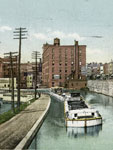Teaser
What pushes and pulls people into new ways of life? In this lesson, students use artifacts, documents, and photographs to help them answer this question.
Description
What pushes and pulls people into new ways of life? In this lesson, students use artifacts, documents, and photographs to help them answer this question.
Article Body
The Henry Ford Museum’s "Early 20th Century Migration—Transportation: Past, Present and Future" is a thematically rich teaching unit. Through artifacts, documents and photographs, students explore the overarching question, What pushes and pulls people into new ways of life? How did the lure of jobs in U.S. factories “pull” Europeans and people of the American South to northern cities and new ways of living? The lessons are both rigorous and relevant, and continuously engage students in considering the impact of the past on the present.
Dubbed an Educator DigiKit, the unit includes extensive materials for teachers. The Teacher’s Guide includes timelines on various historic themes relevant to the lesson topics, a glossary, bibliographies, connections to Michigan and national standards, and field trip suggestions. The lesson plans introduce the assembly line concept, technological and economic forces that cause large-scale migration, fair labor issues, challenges faced by immigrants, and the ongoing changing nature of work up to the present. All of the lessons include links to primary sources in the Henry Ford Museum Online Collection and they utilize a range of activities, including simulations, math-based problem solving, and source analysis.
Teachers will want to consider supplementing this unit by incorporating a rigorous, systematic approach to analyzing primary sources. Borrowing one from another site (see possibilities here) could strengthen the individual lessons and unit. A rich resource, 20th Century Migration honors middle elementary children by challenging them to ponder and interpret significant topics in history that continue to affect their world today.
Topic
Continuity and Change
Rubric_Content_Accurate_Scholarship
Yes
Not only are the details accurate, but the breadth of the perspectives in the lessons helps students develop an accurately complex sense of the unit topics.
Rubric_Content_Historical_Background
Yes
Brief secondary sources provide context for the investigations. For examples, see an essay on the nature of assembly line work on page 44, or a PowerPoint on urbanization that is linked from pages 36 or 37.
Rubric_Content_Read_Write
Yes
Includes a few explicit writing exercises, primarily short-answer assessments. Class discussion questions might be used as writing prompts in older grade levels.
For an example, see writing prompts for primary source analysis on page 55.
Rubric_Analytical_Construct_Interpretations
Yes
Would have liked to see primary source analysis embedded earlier in the unit; it is not introduced until near the end of the unit. The unit would also be more powerful if it introduced a systematic model for source analysis.
Rubric_Analytical_Close_Reading_Sourcing
No
The source analysis guides do not ask students to consider the author or creator of a source. The informal mini-biographies used as primary sources in Lesson 6 are intriguing; the lesson would help students better understand the nature of historical analysis if they engaged them in asking who created the biographies and why.
Rubric_Scaffolding_Appropriate
Yes
The lessons lend themselves to ready adaptation not only in grades 3-5, but for middle school as well.
Rubric_Scaffolding_Supports_Historical_Thinking
Rubric_Structure_Assessment
Yes
Topical knowledge is emphasized in the unit. Nonetheless, the unit does include activities to engage children in interpreting historical documents for basic understanding. No criteria for assessment are included.
Rubric_Structure_Realistic
Yes
The learning goals are topical.
Rubric_Structure_Learning_Goals
Yes
The learning goals are topical.




